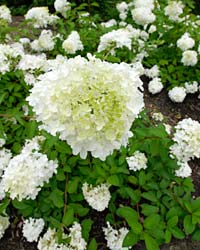Hydrangea spp.
 The hydrangea has come a long way. Once a popular Victorian shrub, it occupied garden space in much the same manner as Grandma’s overgrown lilac bush or the ubiquitous suburban yew. But today’s gardeners are finding that the new varieties satisfy a number of landscaping needs, including shade tolerance, extended bloom time, and winter interest. And for the adventurous gardener, willing to push the horticultural envelope, there are some exciting hydrangeas for selected and protected sites.
The hydrangea has come a long way. Once a popular Victorian shrub, it occupied garden space in much the same manner as Grandma’s overgrown lilac bush or the ubiquitous suburban yew. But today’s gardeners are finding that the new varieties satisfy a number of landscaping needs, including shade tolerance, extended bloom time, and winter interest. And for the adventurous gardener, willing to push the horticultural envelope, there are some exciting hydrangeas for selected and protected sites.
Hydrangeas hardy in Chicago include the climbing (Hydrangea anomala ssp. petiolaris), the smooth (H. arborescens), the panicle (H. paniculata), and the oakleaf (H. quercifolia). The bigleaf hydrangea (H. macrophylla), with its intricate lacecap flowerheads in shades of blue, lavender, pink, or red, is hardy in zones 6 to 8. Some dedicated Zone 5 gardeners have success by siting these plants in sheltered spots and lowering the soil’s pH with regular applications of compost. Growers, anxious to supply hardy lacecap hydrangeas, have turned to cultivars of the mountain hydrangea (H. serrata) as possibilities. A Bloomin' Sale, the Woman’s Board plant sale in May, features some of these unusual cultivars with red, lavender, and blue flowers, variegated chartreuse foliage, and a dwarf oakleaf.
Although hydrangeas are frequently planted in partial shade, most will grow larger and bloom better when given more sun. The dozen cultivars of the panicle hydrangea under evaluation at the Garden are growing in full sun. All hydrangeas prefer moist, fertile soil amended with organic matter such as leaf mold or compost. Most are fairly tolerant of variations in soil pH, but the cultivars of the bigleaf hydrangea can be especially sensitive to acid or alkaline conditions, producing bluer-toned flowers when the pH is between 5 and 5.5 and pinker shades when it’s between 6 and 6.5. Depending on the variety, shrubs will grow from 3 feet (H. arborescens) to 15 feet (H. paniculata), with a wide, spreading habit. Pruning is essential to keep them tidy and blooming. Fertilize all in early spring with a balanced fertilizer.
The flowers are the plant’s most ornamental feature (although the oakleaf’s fall foliage also ranks high), often passing through several color stages before drying to an attractive pink beige. They persist into winter and can be left on the plant, unless the hydrangea requires pruning and they must come off. Depending on the variety, flowers may appear as early as June or as late as September.
Lacecap flower heads are composed of very showy, sterile sepals (often incorrectly referred to as flowers) surrounding a center of inconspicuous, fertile, budlike true flowers. The subtle variations in color, even within the same flower, create fascinating effects. The hortensia or mophead flower heads are densely packed, some round as giant snowballs, some delicately curved with a slightly flat top. Finally, the oakleaf and panicle hydrangeas produce white to pink cone-shaped flowers that can reach 1 foot in length.
See the Garden’s expanding collection of hydrangeas, and look forward to further developments with this versatile shrub.

